Day 68-69 – March 12-13
Torres del Paine, Chile to Cerro Sombrero, Chile to Ushuaia, Argentina
Correction to previous blog 3-11-10:
Helge and Roger were blown off their bikes by the wind and Vincent nearly fell off laughing at the spectacle. Relative to the judging of the Palomo award, of course transparency is the rule in all of South America – and for those of you who have requested the proceedings of the Palomo award deliberations, all you need to do is enter the code used to get on this blog followed by the last three digits of your grandfather’s social security number and submit it to www.argentine.chile/palomoaward/deliberations.com.
March 12
We leave the ritzy Rio Serrano resort hotel just outside of Torres del Paine early in the morning. . .

. . .and bid farewell to Torres del Paine.
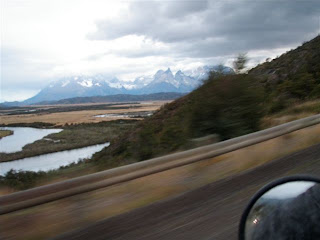
It is beautiful to view from a distance and breathtakingly beautiful to view as Helge and Roger did – up close on their hike up one of the granite spires.
We head southeast with the possible goal of staying in a hostel frequented by motorcycle riders in Cerro Sombrero. We travelled on a lovely gravel road tucked into the mountains. . .

. . .with some beautiful lake vistas.

We passed grazing lands with small rugged trees as tough as the land that they are in:

As we approach Puerto Natales, Chile we pass the town mascot, some sort of prehistoric animal:

Helge investigates potential places to stay in Puerty Natales for next year’s trip. We pass along the Magellan Channel through which the gold miners sailed clipper ships on their way west.

Here is a vessel from the 1860’s that has been beached for 150 years. . .
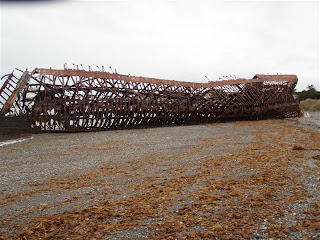
It is steel-framed and oak clad - I didn’t realize that they used steel frames this long ago.

Below the water line they clad the ships in copper to keep the barnacles away. Here you see a strip of copper that has been on the ship for 150 years – in the industrial centers of Cleveland, a piece of copper sitting out in the open wouldn’t last a week!

There’s a substantial tide in the Magellan Strait and it’s one of the reasons the mariners favored using it rather than going around the Horn. Here you see kelp hanging from the deck beams ten feet above the beach:
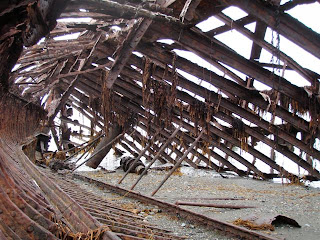
Here’s a later model wreck of a steamship slowly returning to nature – that smoke stack is bound to fall in a high wind:

Its boiler is still intact:
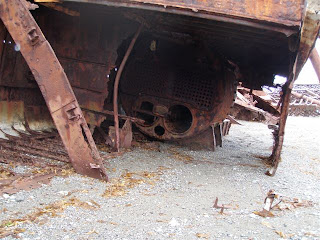
The propeller and its strut are badly corroded, but the propeller shaft is as shiny as the day it was made; and the bearing you see sticking out of the strut, according to Vince, is probably made out of lignum vitae, a heavy dense wood that sinks in water.
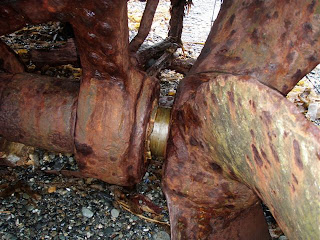
The western end of the Magellan Channel is where ships go to die – ships that would be considered seaworthy under normal conditions but cannot withstand the winds through the strait. There are apparently hundreds of boats that line the bottom and sides of the channel, stripped of anything of value and leaving just the skeletons.
We take a ferry boat in the rain across the Magellan Strait, which takes only 15 minutes:

This will be a 400 km day (nearly entirely in the rain) and I ran out of gas just before reaching our destination – about five miles out. The range of the 6 gallon tank on my bike is between 200-250 miles, largely dependent on speed. Fortunately, I have the extra 1 gallon tank on the back of my panniers – so even in the rain it’s not that inconvenient.
At the lodge in Cerro Sombrero, Chile we run into two more drenched motorcycle groups; one that we have run into from time to time heading south and the other heading north out of Ushuaia. Many of the guys coming from the south didn’t have rain gear and were cold and wet. Both of these groups had chase cars and a motorcycle mechanic traveling with them. We are delighted to be inside and have an excellent dinner while the other groups admire Helge’s fantastic photographs. It rains the entire night.
March 13
The wind howled all night, blowing off my bike cover. Fortunately one of the ropes got tangled up on the bike so I didn’t lose the cover (like Roger lost his) – but with a leather seat covering urethane foam – I will have a wet fanny for the day.
The road surface is dirt covered in gravel with pooled water in each of the chuck holes until we reach the Argentina border. We then follow a paved road through “big sky” country along grasslands with a lot of sheep and llama look-alikes.
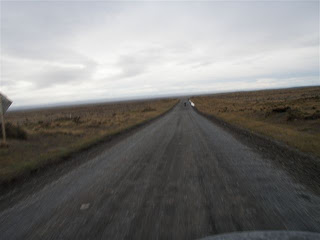
The border crossing is quick and uneventful – we arrive right behind a busload of tourists, but since we have our own vehicles (which need to be imported) we are pushed to the head of the line.
We drive along the Atlantic coast (latitude between 52-53S). At the border there are signs that remind us all that the Falkland Islands belong to Argentina. As we approach Rio Grande, from which the Falkland Island invasion originated, we see signs of military activity. The highway on which we are traveling was used as a military airstrip during the Falkland War – we pass a large radar antenna and had previously seen a large submarine communication system.

The Argentineans are serious about wanting the Islands back and have these sentiments posted on signs everywhere. It’s hard to understand either side of this argument – the Argentines say that the British rotate citizens through and that there are no citizens there that have been resident for any period of time (most of them under 1 year). But the people we run into who have visited the Falklands contradict this claim and state that there are British families that have been there for several generations. The islands are nearly 800 miles away from South America and it appears that neither side is willing to put forth their argument for ownership.
As we pass through Rio Grande we see not only a military but also a strong oil and gas presence. It does not appear to be a very pleasant place to live – the wind is cold and howling even in the summer and rains very frequently.
We continue south along the Atlantic before heading inland. It is largely pastureland with gnarly weather-beaten trees and moss hanging from the branches swept sideways by the wind:
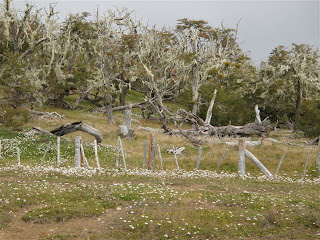
If it weren’t cold, wet and desolate – this could be some nice country. Half way between Rio Grande and Ushuaia, we stop in a very busy bakery and meet the 20 year old young man operating this machine:

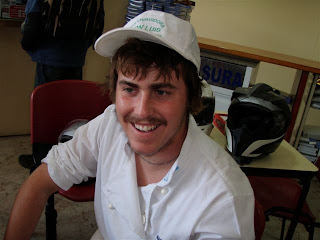
His name is Andrew and he arrived in town 3 weeks ago having ridden his bike the entire way from St. Paul, Minnesota. The owner of the bakery was sympathetic to bike riders and not only offered him a place to stay but a minimum wage job as well. He arrived with the intention of being a shepherd – but he will now learn the trade of a baker, which will have more value for a young man on his walkabout than watching sheep and llama. We had a long talk with him and Helge shared some of his 10 year experience on the road.
After talking with Andrew, I reflected on a personality type such as Andrews – stepping out of the norm requires enormous energy and perseverance. This sort of energy and project orientation will make him an excellent employee for someone. He first wants to get a handle on his interests and not waste his parents’ money on college until he determines a path. He has scratched off shepherd from his list and will undoubtedly scratch off baker – it would be interesting to follow him and find out what path he finally chooses.
As we approach Ushuaia and the southern tip of Argentina we are delighted to see the beautiful mountains and breathtaking vistas:
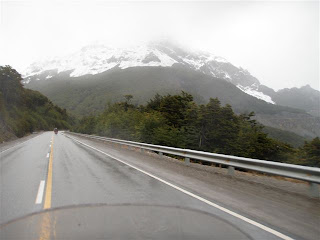
The road is a bit scary – but at least there is a guardrail:

Towards the top of one of the passes, rain turns to snow – we have knobby tires and approach the corners with great care.
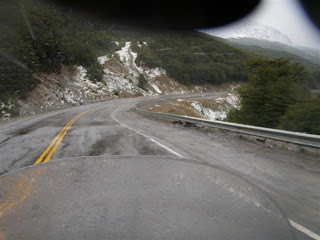
The snow lasts only a short period of time, and finally, while it is still raining, we arrive in Ushuaia – dubbed “the end of the world”!

Ushuaia is declared the most southern city in the world – this fact is based on a population over 2,000 (otherwise Port Williams, Chile is further south).
The sign also informs that Ushuaia began as a penal colony – just as Australia. Ushuaia is the destination from which we will ship our bikes. We will spend our remaining 3 days packaging our bikes for shipment and taking day trips.
We have gone through 13 countries, crossed 20 borders and travelled over 13,000 miles for nearly 2.5 months. We have had a spectacular time – but we are all anxious to get home.
We leave the ritzy Rio Serrano resort hotel just outside of Torres del Paine early in the morning. . .
. . .and bid farewell to Torres del Paine.
It is beautiful to view from a distance and breathtakingly beautiful to view as Helge and Roger did – up close on their hike up one of the granite spires.
We head southeast with the possible goal of staying in a hostel frequented by motorcycle riders in Cerro Sombrero. We travelled on a lovely gravel road tucked into the mountains. . .
. . .with some beautiful lake vistas.
We passed grazing lands with small rugged trees as tough as the land that they are in:
As we approach Puerto Natales, Chile we pass the town mascot, some sort of prehistoric animal:
Helge investigates potential places to stay in Puerty Natales for next year’s trip. We pass along the Magellan Channel through which the gold miners sailed clipper ships on their way west.
Here is a vessel from the 1860’s that has been beached for 150 years. . .
It is steel-framed and oak clad - I didn’t realize that they used steel frames this long ago.
Below the water line they clad the ships in copper to keep the barnacles away. Here you see a strip of copper that has been on the ship for 150 years – in the industrial centers of Cleveland, a piece of copper sitting out in the open wouldn’t last a week!
There’s a substantial tide in the Magellan Strait and it’s one of the reasons the mariners favored using it rather than going around the Horn. Here you see kelp hanging from the deck beams ten feet above the beach:
Here’s a later model wreck of a steamship slowly returning to nature – that smoke stack is bound to fall in a high wind:
Its boiler is still intact:
The propeller and its strut are badly corroded, but the propeller shaft is as shiny as the day it was made; and the bearing you see sticking out of the strut, according to Vince, is probably made out of lignum vitae, a heavy dense wood that sinks in water.
The western end of the Magellan Channel is where ships go to die – ships that would be considered seaworthy under normal conditions but cannot withstand the winds through the strait. There are apparently hundreds of boats that line the bottom and sides of the channel, stripped of anything of value and leaving just the skeletons.
We take a ferry boat in the rain across the Magellan Strait, which takes only 15 minutes:
This will be a 400 km day (nearly entirely in the rain) and I ran out of gas just before reaching our destination – about five miles out. The range of the 6 gallon tank on my bike is between 200-250 miles, largely dependent on speed. Fortunately, I have the extra 1 gallon tank on the back of my panniers – so even in the rain it’s not that inconvenient.
At the lodge in Cerro Sombrero, Chile we run into two more drenched motorcycle groups; one that we have run into from time to time heading south and the other heading north out of Ushuaia. Many of the guys coming from the south didn’t have rain gear and were cold and wet. Both of these groups had chase cars and a motorcycle mechanic traveling with them. We are delighted to be inside and have an excellent dinner while the other groups admire Helge’s fantastic photographs. It rains the entire night.
March 13
The wind howled all night, blowing off my bike cover. Fortunately one of the ropes got tangled up on the bike so I didn’t lose the cover (like Roger lost his) – but with a leather seat covering urethane foam – I will have a wet fanny for the day.
The road surface is dirt covered in gravel with pooled water in each of the chuck holes until we reach the Argentina border. We then follow a paved road through “big sky” country along grasslands with a lot of sheep and llama look-alikes.
The border crossing is quick and uneventful – we arrive right behind a busload of tourists, but since we have our own vehicles (which need to be imported) we are pushed to the head of the line.
We drive along the Atlantic coast (latitude between 52-53S). At the border there are signs that remind us all that the Falkland Islands belong to Argentina. As we approach Rio Grande, from which the Falkland Island invasion originated, we see signs of military activity. The highway on which we are traveling was used as a military airstrip during the Falkland War – we pass a large radar antenna and had previously seen a large submarine communication system.
The Argentineans are serious about wanting the Islands back and have these sentiments posted on signs everywhere. It’s hard to understand either side of this argument – the Argentines say that the British rotate citizens through and that there are no citizens there that have been resident for any period of time (most of them under 1 year). But the people we run into who have visited the Falklands contradict this claim and state that there are British families that have been there for several generations. The islands are nearly 800 miles away from South America and it appears that neither side is willing to put forth their argument for ownership.
As we pass through Rio Grande we see not only a military but also a strong oil and gas presence. It does not appear to be a very pleasant place to live – the wind is cold and howling even in the summer and rains very frequently.
We continue south along the Atlantic before heading inland. It is largely pastureland with gnarly weather-beaten trees and moss hanging from the branches swept sideways by the wind:
If it weren’t cold, wet and desolate – this could be some nice country. Half way between Rio Grande and Ushuaia, we stop in a very busy bakery and meet the 20 year old young man operating this machine:
His name is Andrew and he arrived in town 3 weeks ago having ridden his bike the entire way from St. Paul, Minnesota. The owner of the bakery was sympathetic to bike riders and not only offered him a place to stay but a minimum wage job as well. He arrived with the intention of being a shepherd – but he will now learn the trade of a baker, which will have more value for a young man on his walkabout than watching sheep and llama. We had a long talk with him and Helge shared some of his 10 year experience on the road.
After talking with Andrew, I reflected on a personality type such as Andrews – stepping out of the norm requires enormous energy and perseverance. This sort of energy and project orientation will make him an excellent employee for someone. He first wants to get a handle on his interests and not waste his parents’ money on college until he determines a path. He has scratched off shepherd from his list and will undoubtedly scratch off baker – it would be interesting to follow him and find out what path he finally chooses.
As we approach Ushuaia and the southern tip of Argentina we are delighted to see the beautiful mountains and breathtaking vistas:
The road is a bit scary – but at least there is a guardrail:
Towards the top of one of the passes, rain turns to snow – we have knobby tires and approach the corners with great care.
The snow lasts only a short period of time, and finally, while it is still raining, we arrive in Ushuaia – dubbed “the end of the world”!
Ushuaia is declared the most southern city in the world – this fact is based on a population over 2,000 (otherwise Port Williams, Chile is further south).
The sign also informs that Ushuaia began as a penal colony – just as Australia. Ushuaia is the destination from which we will ship our bikes. We will spend our remaining 3 days packaging our bikes for shipment and taking day trips.
We have gone through 13 countries, crossed 20 borders and travelled over 13,000 miles for nearly 2.5 months. We have had a spectacular time – but we are all anxious to get home.
Back to Top

Add A Comment